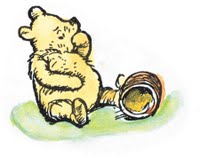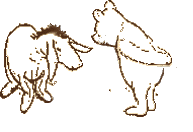
The Honeypot of Alienation
Return to the Hundred Acre Wood is a shocking book because it exists. Nobody (that I know of) has offered to burn it, but it was definitely conceived in sin. Who, you may wonder, "authorized" David Benedictus to mess with A.A. Milne's Winnie-the-Pooh quartet by adding a fifth volume to the series?
The new "friend" created for Pooh, Piglet, Tigger et al. is Lottie the Otter - a concession to feminism totally out of place in the Hundred Acres. Guess it wasn't PC to let Kanga enjoy being the only female in the forest.
Worse yet, Benedictus has compromised Eeyore’s integrity by making him “proactive.” For more than 80 years, Eeyore was the embodiment of unbearable pessimism, an iconic grouch whose self-pity prepared us for the miseries of grown-up affluence. Of all the Hundred Acre dwellers, Eeyore is the one we can least afford to lose. He makes co-dependence and the fear of failure less isolating. He is there during that dark night of the soul - or was, until Benedictus began meddling with the sacred.

It was one thing for Disney to reconfigure Milne's stories and Ernest Shepherd's illustrations. The Disney characters were easy to ignore. A book that purports to be part of Milne's collection is quite a different matter.
Mark Burgess, the illustrator, pays homage to Shepherd, but some characters have turned out better than others. Piglet is the most recognisable, Christopher Robin the least.
Rabbit - so managerial and doctrinaire, the most human character in these woods - has been tragically reconceived by Burgess as a stage bunny.
More about the adult side of A.A. Milne here in the latest issue of The Drawbridge. Last night's radio discussion here.
